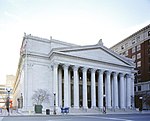Downtown New Haven

Downtown New Haven is the neighborhood located in the heart of the city of New Haven, Connecticut. It is made up of the original nine squares laid out in 1638 to form New Haven, including the New Haven Green, and the immediate surrounding central business district, as well as a significant portion of the Yale University campus. The area includes many restaurants, cafes, theaters and stores. Downtown is bordered by Wooster Square to the east, Long Wharf to the southeast, the Hill neighborhood to the south, the Dwight neighborhood to the west, the Dixwell neighborhood to the northwest, the Prospect Hill area to the north, and East Rock to the northeast. Downtown New Haven is one of the most residential downtown areas in the United States, with nearly 7,000 inhabitants. The expansion of housing options in recent years has helped support downtown businesses and has brought about a surge in economic activity. Secondary streets and areas at the periphery of the neighborhood that once contained vacant storefronts are now almost entirely leased to restaurants and retailers, and the office vacancy rate has dramatically fallen as well.
Excerpt from the Wikipedia article Downtown New Haven (License: CC BY-SA 3.0, Authors, Images).Downtown New Haven
Chapel Street, New Haven
Geographical coordinates (GPS) Address Nearby Places Show on map
Geographical coordinates (GPS)
| Latitude | Longitude |
|---|---|
| N 41.307 ° | E -72.927 ° |
Address
Trinity Episcopal Church
Chapel Street
06510 New Haven
Connecticut, United States
Open on Google Maps






